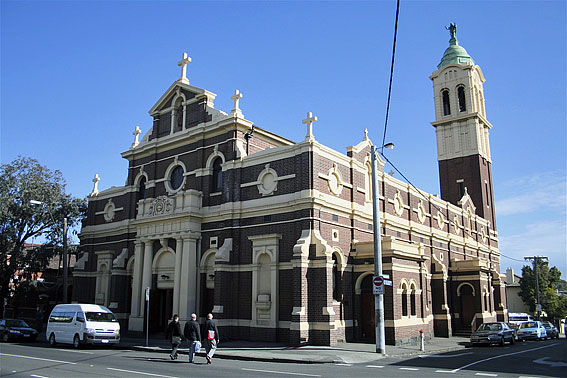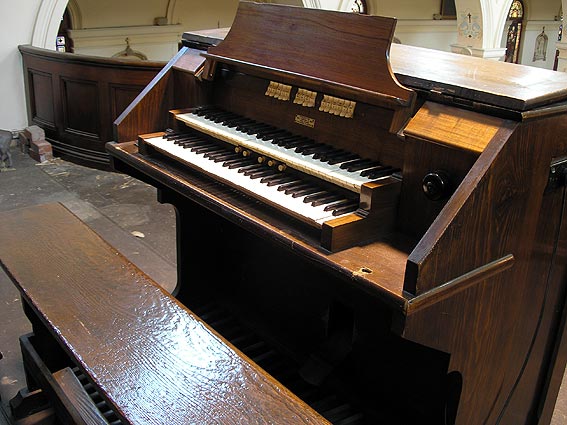Sacred Heart Catholic Church
Grey Street, St Kilda
George Fincham & Son 1910, 2m., 11 sp. st., 3 c., tub. pn.


The first section of Sacred Heart Church, comprising the rear five bays of the present nave, was designed by Reed, Henderson & Smart and opened in 1884. The building was completed in 1922 under the supervision of parishioner W.P. Connolly, architect, at which time three further bays to the nave, the sanctuary and chapels and the tall campanile, with copper dome and statue, were added.
The building is of great importance as the earliest local Catholic church of the period to be designed in a high renaissance idiom rather than the prevailing Gothic style. It is constructed in Hawthorn brick, with cement dressings, and incorporates a broad barrel-vaulted nave with aisles which is brilliantly lit by large clerestory windows. The nave converges upon the sanctuary and high altar which are flanked by chapels. The exterior is dominated by the tall campanile to the north-west which is a prominent local landmark and visible across Port Phillip Bay from Williamstown. The main facade incorporates a Doric portico while the roofs of the side aisles are screened by loft parapets, a technique employed by Christopher Wren at St Paul's Cathedral, London.
The interior is elaborately painted and stencilled throughout, the present scheme of decoration in warm shades of stone and gilt dating from as recently as the 1940s. An extensive programme of redecoration was completed in 1990 by David Mulholland, of Mullholland Bros, and one of the most important of its type to be carried out in the country. The effect is breathtaking.
The fittings include elaborate altarpieces and rails in Italian and Australian marbles. The excellent stained glass, dating from two periods, is possibly by Hardman, of Birmingham and comparable with similar glass at Sacred Heart Church, Carlton. The lunette windows to the left of the sanctuary, the rear rose window, and the almost invisible skylight above the high altar are of particular notes.
The organ was built in 1910 by George Fincham & Son and remains intact, preserving its original tonal scheme, pipework, reversed console, tubular-pneumatic action and unusual casework. The instrument was produced at the time when Herbert Palmer was working for the firm, and the design of the casework may be due to his influence: two other organ cases were produced to this model, for St Cuthbert's Presbyterian Church, Brighton, and the Methodist Church, Highbury Grove, Kew. The console incorporates small pivoted stopkeys based upon a design of Robert Hope Jones. The effect of this small organ is magnified by resonant acoustics and fine placement.
| GREAT Open Diapason Claribel Dulciana Principal Swell to Great SWELL Open Diapason Gedact Echo Gamba Voix Celeste Octave Oboe Tremulant PEDAL Bourdon Great to Pedal Swell to Pedal |
8 8 8 4 8 8 8 8 4 8 16 |
gvd.bass TC |
compass: 58/30
2 thumb pistons to Great
3 thumb pistons to Swell
balanced swell pedal
Notes from Historic Churches and Organs of West St Kilda, Easter Monday - 16 April 1990, Melbourne International Festival of Organ and Harpsichord, compiled by John Maidment
 |
 |
|
 |
 |



Photo above: Trevor Bunning (Oct. 2008)

The church viewed from Williamstown (JRM)
Photos supplied by Simon Colvin, June 2006